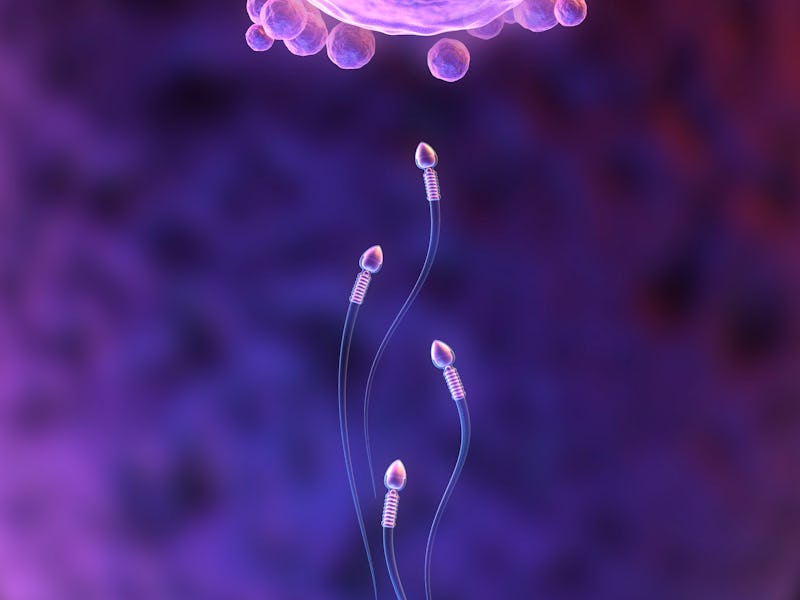New stem cell research could lead to better treatments for male infertility
The success of the experiment took researchers completely by surprise.

In at least one-third of couples who are struggling to conceive, it’s thought the hurdle links back to male reproductive issues. Unfortunately, unlike for women, treatment options for men that actually work are few and far between.
But the findings of a new study could spark hope for the guys who struggle to conceive. Through stem cell transplantation, researchers were able to restore fertility in mice — and the cure might just work for humans in the future.
The findings were published Monday in the journal Proceedings of the National Academy of Sciences.
For the study, the research team took a group of mice that had been chemically castrated – they did this by knocking out a gene called Cldn11. This gene codes for a protein of the same name, which forms a major component of the blood-testis barrier.
The blood-testis barrier is one of the tightest blood-tissue barriers in the body and provides a special environment for spermatogenesis — the production of sperm — to take place. When the mice lacked the CLDN11 protein, it caused big defects in the blood-testis barrier, and spermatogenesis screeched to a halt.
To remedy this, the researchers carried out an autologous stem cell treatment – in which the cells come from one’s own body – on the infertile mice. Specifically, the researchers used spermatogonial stem cells, sperm's precursor cells. These stem cells are known for their unique ability to move from the center to the periphery of the seminiferous tubule, passing through the blood-testis barrier.
When they transplanted spermatogonial stem cells into these mice, they found they were able to re-establish the development of fertile sperm – and fertility was restored.
The success of the experiment took the researchers completely by surprise.
“We did not think that autologous transplantation could work at all,” Takashi Shinohara, a reproductive biologist at Kyoto University in Japan, tells Inverse. He says the only reason they made the finding at all was because they happened to add some additional control experiments.
The cells that make up the blood-testis barrier are called Sertoli cells. When these cells were deficient in CLDN11, they were found to increase the homing efficiency of spermatogonial stem cells by more than three-fold, which suggests that CLDN11 inhibits their transmigration through the blood-testis barrier.
Miles Wilkinson, a professor in the Department of Obstetrics, Gynecology and Reproductive Sciences at UC San Diego, thinks this the study’s most important discovery from a clinical perspective. Wilkinson did not contribute to this study.
“In the future, drugs that target CLDN11 could potentially be used to increase [spermatogonial stem cell] transplantation treatment for human infertility,” he tells Inverse.
Going forward, the research team is curious to know what exactly it is that the blood-testis barrier does.
“Although it is not essential for immunological tolerance nor meiosis, I think that this unique structure must have a role because it is conserved in many species,” Shinohara tells Inverse. “We may be missing something.”
And, one day, these findings may be replicated in humans, and possibly even be used as a cure for some types of male infertility. “Although few groups are working on human spermatogonia at present, I think that it is possible that a similar treatment works in humans,” Shinohara says.
Abstract: The blood-testis barrier (BTB) is thought to be indispensable for spermatogenesis because it creates a special environment for meiosis and protects haploid cells from the immune system. The BTB divides the seminiferous tubules into the adluminal and basal compartments. Spermatogonial stem cells (SSCs) have a unique ability to transmigrate from the adluminal compartment to the basal compartment through the BTB upon transplantation into the seminiferous tubule. Here, we analyzed the role of Cldn11, a major component of the BTB, in spermatogenesis using spermatogonial transplantation. Cldn11-deficient mice are infertile due to the cessation of spermatogenesis at the spermatocyte stage. Cldn11- deficient SSCs failed to colonize wild-type testes efficiently, and Cldn11-deficient SSCs that underwent double depletion of Cldn3 and Cldn5 showed minimal colonization, suggesting that claudins on SSCs are necessary for transmigration. However, Cldn11- deficient Sertoli cells increased SSC homing efficiency by >3-fold, suggesting that CLDN11 in Sertoli cells inhibits transmigration of SSCs through the BTB. In contrast to endogenous SSCs in intact Cldn11-deficient testes, those from WT or Cldn11-deficient testes regenerated sperm in Cldn11-deficient testes. The success of this autologous transplantation appears to depend on the removal of endogenous germ cells for recipient preparation, which reprogrammed claudin expression patterns in Sertoli cells. Consistent with this idea, in vivo depletion of Cldn3/5 regenerated endogenous spermatogenesis in Cldn11-deficient mice. Thus, coordinated claudin expression in both SSCs and Sertoli cell expression is necessary for SSC homing and regeneration of spermatogenesis, and autologous stem cell transplantation can rescue congenital defects of a self-renewing tissue.
This article was originally published on